Grape Jelly Feeders for Birds: A Comprehensive Guide
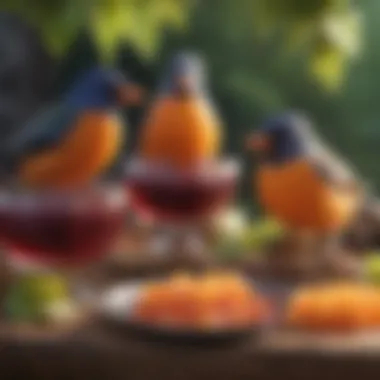
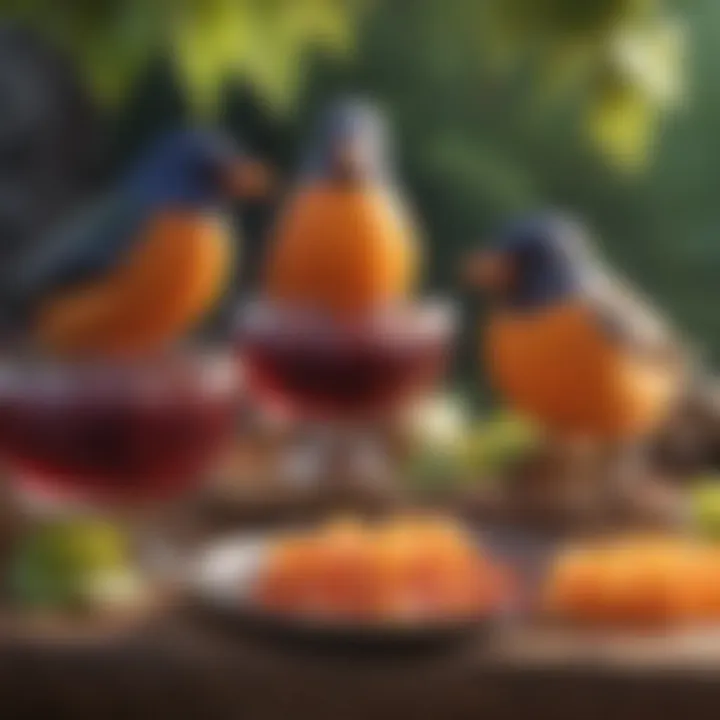
Intro
Birdwatching can feel like opening a window to a whole new world, especially when it comes to attracting diverse species with something as simple as grape jelly. This sugary delight doesn’t just have the capacity to delight our taste buds; it also provides essential nutrition for birds. In this exploration, we'll delve into how grape jelly feeders can entice various birds, their nutritional value, and the setup required to get the most out of this feeding practice.
Many seasoned bird lovers swear by grape jelly as a surefire way to bring in feathered friends. It’s not just about the color and sweetness; it’s about the benefits that come along. Vireos, orioles, and even some warblers show up for an indulgent treat when they spot a jelly feeder. A well-crafted jelly feeder isn’t just functional; it’s an invitation for birds to visit, and it also allows birdwatchers a closer look at these beautiful creatures.
In the sections to follow, we’ll unpack the ins and outs of maintaining these feeders, crafting them from scratch, the nutritional components in grape jelly, and much more. Let’s embark on this journey to become expert bird enthusiasts!
Prelude to Grape Jelly Feeders
Grape jelly feeders have become quite the talk among bird enthusiasts, and for good reason. These unique food sources create an attractive dining spot for a variety of avian species. Not only do they provide a sweet treat that many birds love, but they also offer a way for bird watchers to observe these fascinating creatures up close.
Understanding the Concept
At their core, grape jelly feeders work on a simple premise: they provide a concentrated source of energy for birds, particularly during migration periods or breeding seasons when they require extra sustenance. The jelly is rich in carbohydrates and can be particularly appealing to fruit-loving species. By placing a grape jelly feeder in your yard, you open the door to inviting some delightful feathered friends.
The thought of birds partaking in sweet jelly may conjure images straight out of a child's fantasy. In reality, it resonates with their natural instincts. Birds like orioles, blue jays, and cardinals often forage for soft fruits. Hence, grape jelly becomes an excellent substitute that mimics those food sources. It’s not just a whim; it’s a well-measured step to support their dietary needs.
Historical Context
The concept of utilizing grape jelly in birdfeeding is not as old as one might think. While feeding birds has ancient roots, the practice of using grape jelly specifically began to gain interest in the mid-20th century, primarily in North America. Before then, bird enthusiasts mainly relied on seeds and nuts, overlooking the appeal of jellied fruit.
It is believed that the increase in urban gardening and wild bird appreciation facilitated this innovative feeding method. Bird watchers had begun to notice that certain birds were attracted to human habitats, particularly those where sweet fruits were abundant. Anecdotal reports of birds flocking to jelly led to more gardeners experimenting with feeders laden with these sugary delights.
In summary, grape jelly feeders have emerged as a pathway to foster connection between humans and wildlife, bridging generations of interest in avian activity. As we dig deeper into the nutritional aspects, construction methods, and benefits of these feeders, it becomes evident that this trend is more than just a passing fad—it's an era of enriching birdwatching experiences.
Nutritional Aspects of Grape Jelly
When considering the usage of grape jelly feeders, it becomes essential to delve deep into the nutritional aspects of grape jelly itself. This topic is crucial not only for understanding how it attracts birds but also for ensuring that we provide them with something that supports their health and vitality. Grape jelly, often considered a simple treat, carries with it an array of factors that contribute to the well-being of our feathered friends.
Ingredients Breakdown
Grape jelly, in its most basic form, consists of several key ingredients. While commercial products vary slightly in formula, here are the general components you will typically find:
- Fruit Juice: Generally made from concentrated grape juice, this is the primary ingredient providing natural sweetness. Naturals flavors entice birds and enhance the palatability of the jelly.
- Sugar: Many brands add sugar to boost sweetness. While birds are attracted to sweet treats, it's crucial to be mindful of sugar levels; excessive consumption can lead to health issues.
- Pectin: This is a natural thickening agent often derived from fruit. It helps give jelly its characteristic texture. Pectin is fiber-rich, adding some digestive benefits to the jelly.
- Citric Acid: Often included to stabilize the jelly and enhance shelf life. This is not harmful in small amounts, but too much can alter the taste.
- Preservatives: Some grape jellies have added preservatives. It’s wise for bird caregivers to select options with fewer or no chemical additives, as these can be detrimental over time.
It's always advisable to read the labels carefully when choosing grape jelly. Opt for those with minimal processing and natural ingredients, avoiding unnecessary additives.
Health Benefits for Birds
The myriad of nutrients present in grape jelly can create a positive impact on bird health, provided it is given in moderation. Here are some significant benefits:
- Energy Boost: Grape jelly is high in sugars, which can give birds a quick energy boost, especially during migration or breeding seasons when they need that extra vitality.
- Antioxidants: Grapes are rich in antioxidants, which can help combat oxidative stress in birds, potentially improving their immune function.
- Attracts Diverse Species: Offering this sweet treat can attract various bird species. This is particularly important for avian biodiversity, supporting varied diets in residential areas.
- Supplemental Diet: While grape jelly should not replace main dietary components—like seeds or insects—it serves as an excellent supplement for birds that might need extra calories during breeding, molting, or colder months.
"Birds are smart. They learn quickly what is available. Grape jelly can become an integral part of their feeding behavior when introduced in a safe and healthy manner."
While the nutritional advantages are significant, it’s prudent to consider the overall balance in a bird's diet. Over-reliance on sweet foods like grape jelly may disrupt their natural feeding habits. Providing grape jelly as an occasional treat ensures birds enjoy this concoction without negatively affecting their health.
Choosing the Right Feeder
Selecting the appropriate grape jelly feeder is crucial for effectively attracting various bird species. The right choice not only enhances the feeding experience for birds but also ensures that the jelly remains accessible and hygienic. A well-chosen feeder can significantly affect the volume and variety of bird visitors, making this decision pivotal for any bird enthusiast.
Types of Grape Jelly Feeders
When thinking of grape jelly feeders, one finds a variety of options that cater to different preferences and bird species. Here are some common types:
- Hanging Feeders: These are typically suspended from tree branches or hooks. Their design allows for easy access for birds while keeping the jelly away from ground predators.
- Platform Feeders: These feeders are flat, offering a wide surface for birds to perch on while feasting. They can attract larger birds, but they may also invite unwanted pests.
- Wall-Mounted Feeders: Ideal for smaller yards, these can be attached to home windows or walls. They're aesthetic and make bird watching easy right from indoors.
- Portable Feeders: These feeders are great for those who move locations frequently. Lightweight and easy to hang, they can be packed for outings or trips.
Each type of feeder has its pros and cons. For instance, while hanging feeders keep jelly safe from most terrestrial animals, they may pose challenges in windy weather. Conversely, platform feeders might invite larger avian visitors but risk contamination due to accessibility.
Materials and Construction
Choosing the right materials for grape jelly feeders is as essential as selecting the type of feeder. Different materials come with their own set of advantages:
- Plastic: Lightweight and often less expensive, plastic feeders can be colorful and may attract birds visually. However, they can fade or crack under prolonged exposure to sunlight.
- Glass: Glass feeders are generally easier to clean and keep the jelly fresher due to non-porous surfaces. They tend to look nicer too, blending well into garden settings. However, they can be heavier and less durable than some plastics.
- Wood: Wooden feeders can provide a rustic charm. Treated wood can withstand the elements, but untreated wood might absorb moisture and become a breeding ground for mold.
When constructing your own feeder, aim for a design that minimizes jelly spillage and encourages easy cleaning. A common approach is to create a shallow basin with a rim that stops jelly from spilling out while allowing birds to easily reach it. Sustainability is key as well; consider sourcing materials that are eco-friendly to minimize your footprint while feeding our feathered friends.
Choosing the right feeder means unlocking a world of avian visitors to your backyard, enhancing both their diet and your own enjoyment in the process.
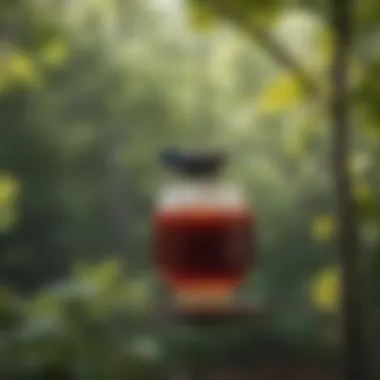
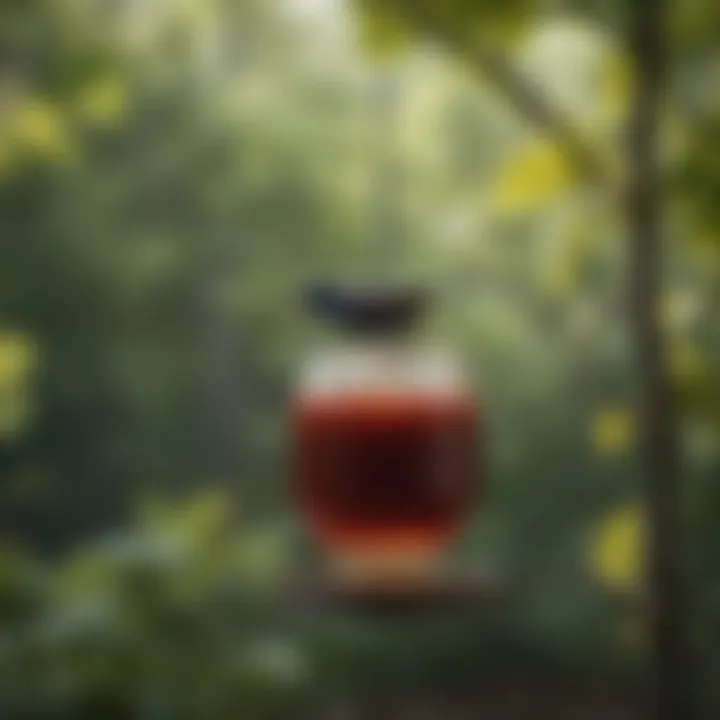
Popular Bird Species Attracted to Grape Jelly
Understanding the specific bird species that are drawn to grape jelly can significantly enhance one’s bird feeding experience. Using grape jelly feeders is not just about feeding the birds; it’s about attracting a rich variety of species that may not be frequent visitors to standard seed feeders. This segment will tackle the various species that typically gravitate towards grape jelly, their unique characteristics, and the joys and responsibilities this entails for bird enthusiasts.
Identification of Key Species
Several bird species have developed a taste for grape jelly, making them the primary fans of this sweet snack. Among the most common are:
- Orioles: Their bright plumage is hard to miss, and these birds are well noted for their fondness for grape jelly. The Baltimore oriole in particular is a summer visitor in many parts of the U.S. and brings a vibrant splash of color to any garden.
- Black-headed Grosbeaks: These birds are known for their melodious songs and also enjoy grape jelly, especially during migration.
- Ruby-throated Hummingbirds: While they primarily drink nectar, they will occasionally indulge in grape jelly, making feeders a great way to attract them.
When setting up feeders, it is essential to ensure that the jelly is easily accessible. Utilizing innovative feeder designs can facilitate access for birds while keeping out larger, unwanted visitors. It's also crucial to use pure grape jelly without added sugars or artificial sweeteners, as these can be harmful to birds.
Seasonal Variations in Visits
It’s worth noting that the frequency and type of bird visitors to grape jelly feeders can change significantly with the seasons.
- Spring Migration: Springtime often marks an uptick in visits, as migratory birds return to their summer breeding grounds. Orioles, for instance, return to the Eastern United States, attracted by already set-up feeders.
- Summer: Once they’ve nested, parents will frequently visit feeders to sustain themselves and their chicks. This is when grape jelly feeders can be particularly busy.
- Fall: As birds prepare to migrate south, they may increase their jelly consumption, stocking up on calories for their long journey.
- Winter: In colder months, fewer species may frequent these feeders. However, some year-round residents like certain sparrows may still find their way to the jelly, especially when natural food sources diminish.
The seasonal shifts in bird activity underscore the importance of consistent feeder maintenance and awareness of the birds’ needs throughout the year. By adjusting feeding practices accordingly, bird enthusiasts can enjoy a dynamic and varied birdwatching experience.
Engaging with these species offers not just visual delight but also a deeper understanding of their behaviors and needs. Clinging to the grape jelly feeders is like witnessing a live nature show that unfolds on your backyard stage.
Best Practices for Feeding Birds
Feeding birds with grape jelly is like putting out an irresistible buffet in your yard. However, it’s not just about slapping some jelly in a jar and calling it a day. There are best practices that can enhance the experience for both the birds and the feeder’s owner. Understanding these practices can facilitate healthier feeding habits and ensure that the birds come flocking back day after day.
Optimal Placement of Feeders
First things first, the placement of your jelly feeder is crucial. Observing where your neighborhood birds like to hang out can provide a hint. Look for trees, fences, or even your windows that might serve as strategic perches. Place the feeder at least five to ten feet away from crowded areas, such as bushes or dense tree limbs, to prevent predators from ambushing the unsuspecting.
- Visibility: Birds are more likely to find the feeder if it's in an open spot that's easily visible. Think about locations that have a good view but also a bit of shelter, so the birds feel safe.
- Height: Positioning the feeder at an eye-level or slightly higher can make it more appealing. Most small birds like to feed at varried heights.
- Sunlight Consideration: Placing feeders where they catch morning sunlight could help melt any jelly that freezes overnight during colder months. Conversely, avoid direct sun in hotter months to keep the jelly from spoiling.
A little experimentation may yield varying success rates. If birds aren’t showing up initially, try moving the feeder a few feet. It could be the difference between a ghost town and a bustling bird café.
Frequency and Quantity of Jelly
When it comes to serving size, moderation is key. It offers a balance that attracts birds without overwhelming them. Too big a dose, and the jelly might ferment or attract unwanted pests.
- Daily Checks: It's wise to check your feeder daily, especially in warm weather. Replace the jelly if it looks cloudy or if the birds haven't been visiting much.
- Recommended Amounts: A couple of tablespoons per feeding should be sufficient. Some might think more is better, but this can lead to wasted jelly and potential contamination. Consider the time of year, as bird populations will fluctuate, and so should the quantity of jelly.
- Keep it Fresh: If you're going to put out jelly, only leave it out for one day. This maximizes freshness and minimizes risk to the birds.
Feeding birds should be an enjoyable practice, so understanding the factors affecting feeding behavior could considerably boost your backyard's avian visitors. Creating a welcoming atmosphere is sure to turn just a handful of moments into a delightful ritual of wildlife observation.
"The best feeders are those that blend seamlessly with nature while catering effectively to the avian community."
Ultimately, it’s all about fostering good relationships with our feathered friends and ensuring they visit often and thrive. Keeping practices in check not only helps with your local bird population but turns every feeding into a small gathering of nature’s beauty.
Potential Drawbacks of Grape Jelly Feeders
While grape jelly feeders are quite popular among bird enthusiasts, they do come with their set of challenges. Understanding these potential drawbacks is important for anyone looking to create an effective feeding environment for their feathered friends. By analyzing both health risks for birds and broader ecological impacts, one can ensure that feeding practices do not inadvertently harm local wildlife or disrupt the natural balance of the ecosystem.
Health Risks for Birds
Grape jelly, although appealing to many avian species, can present certain health risks. The sugar content is notably high, which can lead to various complications if consumed in excessive amounts. Birds, much like humans, rely on a balanced diet. Overindulgence in sugary foods can result in obesity and subsequent ailments like fatty liver disease.
Furthermore, if the jelly is not kept fresh, it can mold. Molds can produce toxins that are harmful, or even fatal, to birds. Regular monitoring is crucial to ensure that the jelly is safe for consumption.
To be sure your feeding setup remains healthy:
- Change the jelly frequently, ideally every few days.
- Store jelly in a cool place to prevent premature spoilage.
- Use containers that are easy to clean to avoid bacterial growth.
By paying attention to such factors, one can mitigate the health risks associated with grape jelly feeders.
Impact on Local Ecology
The introduction of grape jelly feeders can have a ripple effect on the local ecology. When birds flock to these feeders, it can be tempting to view it purely as a positive. However, concentrated feeding can lead to several unintended consequences.
- Dependency on Feeders: Birds may begin to rely heavily on the jelly, reducing their foraging behavior. This dependency can alter their natural feeding habits, making them less capable of finding food in the wild.
- Attracting Non-Native Species: Grape jelly can attract not just desirable bird species but also those that may not belong in the area. This could potentially disrupt the balance and lead to competition for resources.
- Increased Predation Risks: As feeders attract birds, they can also draw in predators such as cats or raptors. This can lead to higher mortality rates among the bird populations that frequent these feeders.
Maintenance and Hygiene Considerations

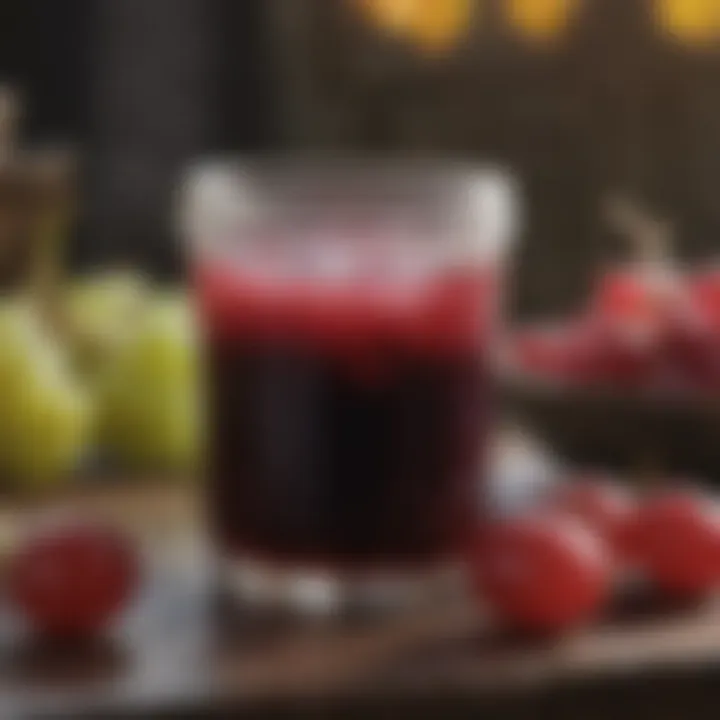
Proper maintenance and hygiene are fundamental for ensuring that grape jelly feeders function effectively and provide a safe source of nourishment for birds. Many aspiring bird parents might underestimate the importance of keeping their feeders clean, believing that occasional refreshing of the jelly is enough. However, ensuring ongoing cleanliness goes beyond just topping off with a fresh spoonful. It can significantly impact the health of the birds that visit and the overall success of attracting a variety of species.
Maintaining a clean feeding environment can help prevent the buildup of molds and harmful bacteria. Pests might also find their way to these feeders, and hygiene practices can mitigate such challenges. Therefore, keeping a close eye on both the cleanliness of the solution offered and the feeder itself should be at the forefront of a bird lover's routine.
- Benefits of Proper Maintenance:
- Reduces the Risk of Disease: Regular cleaning and checks can minimize respiratory issues and other illnesses in birds, which often arise from contaminated food sources.
- Enhances Attraction: A well-kept feeder is more likely to draw in a range of species. The joy of seeing various birds flock can be diminished if the feeder appears neglected.
- Increases Durability: Regular upkeep ensures that the materials of the feeder remain intact and functional over time, saving costs in replacements.
By prioritizing maintenance, bird enthusiasts contribute positively to the avian community and can relish deeper connections through their birdwatching endeavors.
Cleaning Procedures
When it comes to cleaning grape jelly feeders, a systematic approach is crucial. Many local birdwatching groups suggest cleaning both the feeding area and the parts that might not seem dirty at first glance. Keeping up with these procedures ensures that no harmful residue builds up. Here’s how to effectively clean your grape jelly feeder:
- Remove the Feeder: Take the feeder down from wherever it hangs to avoid additional mess. This makes it easier to clean thoroughly.
- Dispose of Old Jelly: Empty any remaining jelly; do not let it sit too long. Leftover jelly can spoil and attract unwanted pests.
- Soak and Scrub: Use a mixture of warm water and mild soap to soak the feeder for a few minutes. A soft brush is handy for scrubbing away any stubborn residue or mold.
- Rinse Thoroughly: Ensure all soap is removed; even small amounts can harm birds. Rinse under running water until clear.
- Sanitize: For additional peace of mind, a solution of one part vinegar to four parts water can be used for a final sanitization. Allow it to sit for a few minutes before rinsing again.
- Dry: Let the feeder air dry completely before refilling to prevent unwanted moisture from ruining the fresh grape jelly.
"Regular cleaning is the cornerstone of a functional grape jelly feeder. It not only protects the birds but also enhances their visiting experience."
By integrating these cleaning procedures into a routine schedule, bird lovers can assure that they are not only feeding birds but doing so in a nurturing and safe manner.
Signs of Contamination
It’s essential to be vigilant about the signs that might indicate feeder contamination. Catching issues early can save the lives of birds relying on the feeder, and it also promotes a sustainable birdwatching environment. Here are some red flags:
- Mold Growth: Spots of white or green mold around the feeder’s openings or inside are a clear sign that it needs immediate cleaning.
- Unpleasant Odors: A foul smell often accompanies spoiled jelly. If the feeder emits an unusual scent, it needs to be cleaned promptly.
- Excessive Pests: If you notice a significant number of insects or ants around the feeder, it can signal that it’s time to clean and perhaps even investigate the jelly's ingredients. A clean feeder should deter pests effectively.
- Discoloration of Jelly: Fresh grape jelly should maintain its signature hue. If it appears darker or shows signs of crystallization, that’s a clear indication it’s time for a change.
- Bird Behavior: If birds suddenly stop visiting, it could point to an issue. Keeping track of regular visitors can provide insight into any changes in interest, possibly due to feeder conditions.
Observing these signs can greatly enhance the overall health of the local bird population and ensure a thriving feeding experience for both the birds and the owner.
Environmental Factors Affecting Feeding
Understanding how environmental factors impact feeding can greatly enhance the effectiveness of grape jelly feeders for attracting birds. Numerous elements, such as weather conditions and seasonal changes, play a crucial role in determining bird activity and their feeding habits. Grasping these dynamics enables bird enthusiasts to optimize their feeding strategies, ensuring that their grape jelly offerings are appealing and accessible.
Weather Considerations
Weather undoubtedly influences bird behavior and can dictate their feeding patterns. On a sunny day, birds are likely to be more active, flitting around in search of food. However, during inclement weather—be it raining cats and dogs or snow falling in thick sheets—birds might be less inclined to venture out.
Key aspects of weather considerations include:
- Temperature Effects: Cold temperatures can drive birds to seek out high-calorie foods. Grape jelly, with its sugary content, might be a preferred choice during these times.
- Rain and Wet Conditions: Rain can discourage birds from feeding. Grape jelly feeders should be placed under some shelter to keep the food dry and accessible.
- Wind Strength: Strong winds may deter smaller birds. In such cases, placement of feeders in sheltered areas can make a difference.
"Understanding the weather can be like deciphering a puzzle for those vying to attract birds—knowing when to feed can lead to greater visits from feathered friends."
Time of Year and Bird Behavior
The time of year can influence not just the species of birds that are attracted but also their feeding frequency and preferences. During migration seasons, for instance, specific bird species will appear at feeders as they travel between habitats. Knowing when these migrations occur can help in maximizing the bird-watching experience.
Factors to keep in mind with seasonal changes include:
- Spring Awakening: As birds return from their winter retreats, they seek nutritious food sources to regain energy and fat reserves. Grape jelly can be an excellent offering during this time as it provides quick energy.
- Summer Feasting: During the warmer months, many birds may have young to feed, and they look for high-energy sources to sustain their offspring. Keeping grape jelly feeders stocked during this vibrant season can yield an uptick in visits.
- Autumn Migration: In the fall, migratory birds pass through densely populated areas. Ensuring feeders are filled with grape jelly can provide essential nourishment for these travelers.
- Winter Challenges: Food can be scarce in winter. Birds will flock to reliable food sources, and grape jelly can serve as a supplemental energy source that could potentially save lives during harsh conditions.
By tuning into these environmental factors, owners can strategically place feeders and manage jelly supplies to cater to the changing whims of their avian guests. This understanding, combined with attentive observation, transforms feeding from a mere task into a rewarding experience, forging a connection with nature right outside one’s window.
Comparative Analysis: Grape Jelly vs. Other Feeders
When it comes to bird feeding, enthusiasts often find themselves at a crossroads deciding between grape jelly feeders and other feeding methods. This analysis sheds light on the distinctive qualities of grape jelly and how they compare to alternative feeding options. Understanding these contrasts is vital for bird lovers seeking to create an inviting habitat for their feathered friends.
Nutritional Comparison
Grape jelly, with its high sugar content, offers a quick energy boost that many birds gravitate toward, especially those with faster metabolisms. Different feeders serve various food types, from seeds to suet, but each option has its own nutritional profile.
- Grape Jelly:
- Seed Feeders:
- High in carbohydrates; suitable for hummingbirds and fruit-eating species.
- Lacks protein and fats, often needed for overall bird health.
- Provide essential fats and proteins.
- Draw a broader range of birds, but less attractive to species like orioles or tanagers.
In particular, if a bird is on the hunt for quick energy, they might prefer the sweet allure of grape jelly over the gritty seeds of traditional feeders. However, successful bird care strategies often involve balancing different food sources to ensure various dietary needs are met. With grape jelly, it’s crucial to complement this treat with high-protein offerings.
Attraction Rates Among Different Feeders
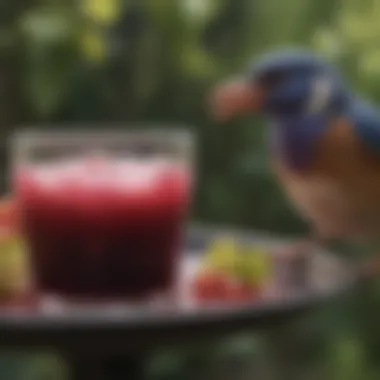
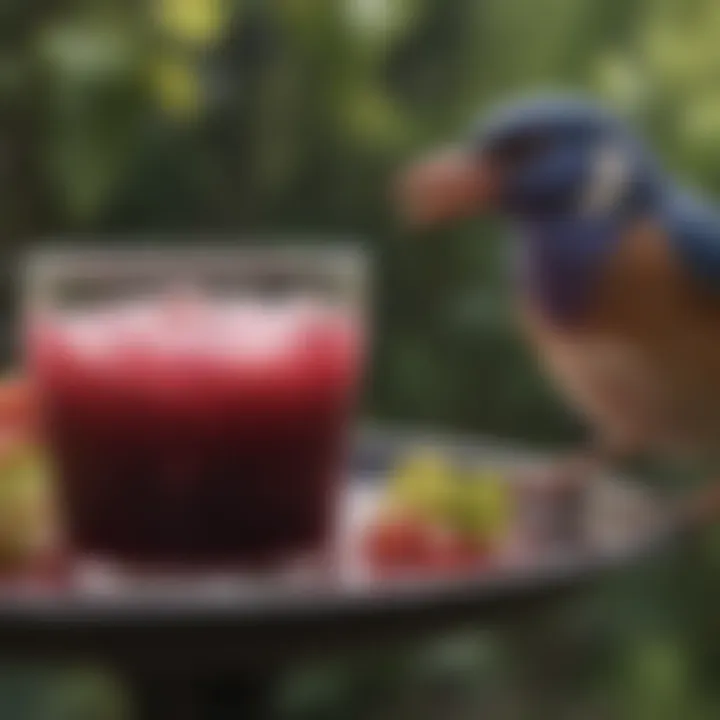
The effectiveness of grape jelly feeders versus others can be quantified by examining visitation rates by specific bird species. Grape jelly feeders tend to attract a few species that have a particular penchant for sweet offerings.
- Grape Jelly Feeders:
- Seed Feeders:
- High visitation from orioles and hummingbirds.
- Optimal use during spring and summer when these species are most active.
- Offer a wider allure, attracting a mix of birds like sparrows, finches, and doves.
- Greater competition due to diverse diets of visiting species.
"While grape jelly feeders shine in attracting specific sweet-loving birds, combining various feeding strategies can maximize your backyard's bird-watching experience."
Evidently, each feeder type will yield different attraction rates based on seasonality and regional species preferences. If birdwatchers are targeting specific species like orioles, grape jelly might just tip the scales in their favor. However, a combination of feeders allows for a more robust array of avian visitors.
In summary, the choice between grape jelly feeders and other alternatives ultimately hinges on the bird species you wish to attract, as well as providing a holistic approach to avian nutrition. This detailed comparison not only informs about the nutritional aspects but also guides enthusiasts in optimizing their feeding practices.
Case Studies and Success Stories
The examination of grape jelly feeders for birds extends beyond just a theoretical grasp; it finds strength in rooted narratives from those who have experienced success firsthand. Personal accounts and scientific research intertwine to paint a vivid picture of how these feeders can transform backyard experiences into a delightful birdwatching haven. By delving into real-life examples, we can appreciate the practical advantages of grape jelly feeders, as well as the nuances associated with attracting diverse bird species to your space.
Personal Experiences of Bird Enthusiasts
Many bird enthusiasts, from the amateur to the more seasoned, have taken to grape jelly feeders as a prominent tool for attracting feathered visitors. These accounts often begin with a simple motivation—a desire to increase avian activity in their backyards. For example, Alice, a retired educator from Oregon, decided to hang a grape jelly feeder near her kitchen window. She was amazed to see Baltimore Orioles swooping in almost immediately. Alice noted that the bright colors of the feeder seemed to catch the birds' attention, and soon enough, she had a regular parade of visitors.
Another interesting case comes from Greg, who lives in a more urban area of New York. He initially thought few birds would dare to visit his vicinity due to the concrete jungle surrounding him. However, after a week of placing a grape jelly feeder mixed with fresh fruits, he was pleasantly surprised by the arrival of House Finches and Catbirds. His enthusiasm for this unexpected turnout only underscored the versatility of grape jelly feeders. These personal tales not only amplify the joy of birdwatching but also showcase the feeders' potential to create connections with nature, even in less-than-ideal locations.
Research Findings on Bird Attraction
Scientific studies buttress these anecdotes and reveal a fascinating insight into avian behavior in relation to grape jelly feeders. Research has indicated that grape jelly serves as a swift energy source for migrating birds, particularly during spring and fall migrations when food scarcity might be at its peak. One study published in the Journal of Avian Biology found that specific species, such as Hummingbirds and Orioles, showed significant preference for feeders stocked with grape jelly over traditional seed feeders.
Additionally, researchers noted that the sugar content in grape jelly resembles that of nectar, making it a reliable food source for birds. Many enthusiasts have shared findings that when grape jelly is available, birds will prioritize it, often returning every day for a fix of this sugary delight. > "Our study shows that grape jelly feeders can significantly increase the diversity and number of birds in suburban environments," a researcher remarked during a conference.
These findings suggest that grape jelly feeders are not just a novelty, but rather a functional addition to the diets of many species. With a sprinkling of statistics and individual stories, the combination of casual accounts and serious research forms a robust understanding of grap jelly feeders' efficacy in supporting bird populations.
Both personal experiences and research outcomes together build a compelling narrative that encourages bird lovers to integrate grape jelly feeders into their feeding routines, fostering an engaging and vibrant relationship with the avian world.
Future Trends in Bird Feeding
The world of bird feeding is experiencing a transformation as enthusiasts increasingly seek to enhance their interactions with nature. As bird lovers, understanding future trends in bird feeding is essential. It reflects changing attitudes toward sustainable practices and technological advancements that not only attract birds but also encourage healthier environments for them.
Technology Integration in Feeders
The integration of technology into bird feeders is gaining momentum. Smart feeders equipped with sensors are making it easier for bird enthusiasts to monitor feeding habits. These feeders can connect to smartphones and provide real-time data on bird activity. Imagine receiving a notification when a brightly colored oriole stops by for a snack!
Furthermore, these technological innovations often include features like:
- Automated feeding schedules: This ensures birds have access to food at optimal times, which can lead to more frequent visits.
- Camera integration: Observing birds feeding via a live stream creates an intimate connection between the user and nature.
- Data collection: By tracking which species visit, users can contribute valuable information to wildlife studies and local conservation efforts.
It's not just about attracting birds; it's also about understanding their needs and behaviors. Such advancements in technology are paving the way for more informed bird feeding practices.
Sustainability Considerations
As our awareness of environmental issues grows, sustainability remains at the forefront of future trends. Bird enthusiasts are turning to sustainable feeding practices that are not only beneficial for birds but for the ecosystem overall.
Using organic grape jelly, for example, helps ensure that what birds are consuming does not harm their health or the environment. Furthermore, opting for feeders made from recycled materials reduces waste and promotes a circular economy. Consider these important sustainability factors:
- Eco-friendly materials: Look for feeders constructed from bamboo or repurposed plastics, which are gentle on the planet.
- Local sourcing: Buying jelly produced locally supports small businesses and reduces carbon footprints associated with transportation.
- Creating natural habitats: Incorporating feeders within a diverse garden filled with native plants encourages local bird species to thrive, promoting biodiversity.
"By embracing sustainable feeding practices, bird lovers can support not only the avian visitors but also the entire ecosystem they inhabit."
Adopting these sustainable habits doesn't just benefit birds. They also make our own backyards more vibrant and life-filled spaces.
Epilogue
The importance of grape jelly feeders goes beyond mere aesthetics in bird watching; they serve as vital tools for attracting and nurturing a variety of bird species. Given their sweet appeal, grape jelly feeders can transform an ordinary backyard into an avian haven. Essential points discussed throughout the article highlight how these feeders not only dispense nutritional benefits but also contribute directly to bird welfare in regions where natural food sources may be scarce.
In addressing the various aspects of grape jelly feeding, including nutritional value, construction methods, and maintenance practices, the findings lay a comprehensive path for both novice and expert bird enthusiasts alike.
Recap of Key Points
- Grape jelly offers vital nutrients that many birds seek, especially during migration and breeding seasons.
- Different types of feeders employ varying designs and materials, each with their own set of advantages.
- Proper placement and hygiene practices are crucial for maintaining a safe feeding environment for birds.
- Environmental factors can directly impact the effectiveness of such feeders, making timing and local conditions essential considerations.
Final Thoughts on Bird Feeding
Utilizing grape jelly feeders presents an intriguing avenue for those passionate about birdwatching. It encourages engagement with local wildlife while promoting healthy feeding practices. As the article has explored, there’s much to learn and implement in the world of bird feeding, particularly regarding sustainability and technology integration in feeder designs. By empowering our feathered friends through thoughtful feeding, we contribute to their survival and appreciation of the natural world around us.
Bird feeding is not just a hobby; it’s a gateway to understanding our ecosystem better. Therefore, taking the plunge into grape jelly feeders could offer not only joy but also invaluable learning experiences.















